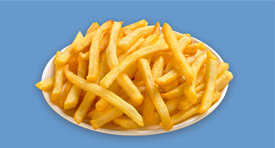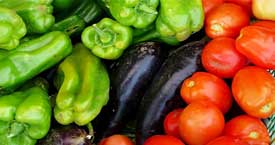Many scientists, physicians, therapists stress the fact that correct nutrition could be very helpful in fibromialgia syndrome treatment. Appropriate diet may ease the symptoms and foster remission of illness. Some substances that play key role in fibromyalgia course are strictly connected with diet.
Serotonin and Tryptophan
Disrupted metabolism of serotonin plays key role with no doubts among various causes of fibromyalgia syndrome. Serotonin is often characterized as a happiness hormone. It is a substance that has key function in our wellbeing and mood. It has been scientifically confirmed that increased serotonin level in the brain promotes good mood. On the other hand low serotonin level was found in persons with depression. Tryptophan is a starting substance for serotonin formation by our nervous system. It is so called an essential amino acid that cannot be synthesized (from scratch) by the organism, and thus must be supplied in our diet like a vitamin. Natural, good sources of tryptophan are protein rich products eg.: dairy products (cottage cheese, hard cheese), milk, yoghurt, kefir, soy products, pumpkin seeds, bananas spirulina, eggs, meat – particularly chicken and fish. Tryptophan content in various foodstuff has been presented in the table below.
Tryptophan Content
in 100 g of chosen foodstuff
|
Foods of Plant Origin |
Foods of Animal Origin |
|---|---|
|
|
Proteins and carbohydrates present in our diet have influence on tryptophan absorption. Protein rich products reduce tryptophan absorption due to high content of long chain amino acids. It comes to the competition between amino acids and its acquiring by the brain decreases. In contrary carbohydrates improve tryptophan absorption for our food because they increase insulin secretion which improves long chain amino acid utilization by skeletal muscles and thus facilitate crossing blood-brain barrier by tryptophan.
Taurine
Taurine naturally occurs in shellfish, fish and meat products. Vegatables products provide approximatelly 1000 times less taurine content. No taurine was found either in hen eggs (yolk or white) or in dairy products or in honey. Taurine was undetectable in fruits and vegetables. From the seeds, cereals and grains examined, rice, corn, oatmeal, rye, wheat, barley, sesame seed, coffee and cacao, contain no taurine.
|
|
Food Recommended in Fibromyalgia
Pineapple Fruit and Stem Extract

Bromelain – a proteolytic enzyme of pineapple – draws scientists close attention. Bromelain is potent anti-inflammatory agent that eases pain and swelling and supports tissue healing. It is an enzyme that decomposes and congeals protein, and occurs in fresh pineapple naturally. There are several scientific evidences that orally taken bromelain is assimilated intact even in 40 %. Bromelain in tablets was used in these tests, however we cannot exclude that fresh pineapple fruit or juice may show the same activity.
If you would like to get comprehensive information about bromelain click the link beside → Bromelain Monography (pdf file)
Olive Seed Extract

Oleocanthal is natural organic constituent of olive plant. It occurs in various parts of the plant like leaf, root, however, in large quantities in olive fruit and olive seed in particular. It belongs to the polyphenols family, substances with antioxidant properties. The importance and uniqueness of oleocanthal is that it demonstrates antinociceptive*, anti-inflammatory, and antioxidant activity.
In the last years there have been done some essays to check the potential benefits of oleocanthal.
* antinociception – the action or process of blocking the detection of a painful or injurious stimulus by sensory neurons
Daisy Leaf Extract

Daisy – Latin Bellis perennis has been used in herbal medicine. In ancient Rome, the surgeons who accompanied Roman legions into battle would order their slaves to pick sacks full of daisies in order to extract their juice. The word "bellum" stands for war or fight in Latin. This may be the origin of this plant's scientific name. Bandages were soaked in this juice and would then be used to bind sword and spear cuts.
The medicinal properties of Bellis perennis have been recorded in herbals as far back as the 16th century. Daisy was recommended as a remedy for heavy menstruation, migraine, and to promote healing of bruises and swellings.
If you would like to get comprehensive information about daiisy leaf extract click the link beside → health benefits of daisy leaves
Grapevine Leaf Extract

Grapevine leaves, a popular staple of heart-healthy Mediterranean cuisine, are rich in vitamins and minerals. Grapevine leaves are mildly anti-inflammatory based on a rating system that estimates the inflammatory potential of foods and food combinations. Chronic inflammation is may cause certain illnesses and diseases, such as heart disease, many types of cancer and Alzheimer's disease. Other diseases that are a result of inflammation include arthritis and many gastrointestinal diseases, such as Crohn's disease. While lifestyle and genetics contribute to chronic inflammation, maintaining a diet that is healthy and low in inflammatory foods is the best strategy for containing it and reducing long-term disease risks.
If you would like to get comprehensive information about grape leaf extract click the link beside → health benefits of grapevine leaves
Lacerda DS, Costa PC, et al Benefits of Vine Leaf on Different Biological Systems Grape and Wine Biotechnology, 2016
Robertson S. Grapevine leaf extract inhibits SARS-CoV-2 and HSV-1-replication in the lab News Medical Life Sciences
Aouey B, Samet AM, et al Anti-oxidant, anti-inflammatory, analgesic and antipyretic activities of grapevine leaf extract (Vitis vinifera) in mice and identification of its active constituents by LC–MS/MS analyses BIomedicine & Pharmacotherapy 2016, 84, 1088-98










